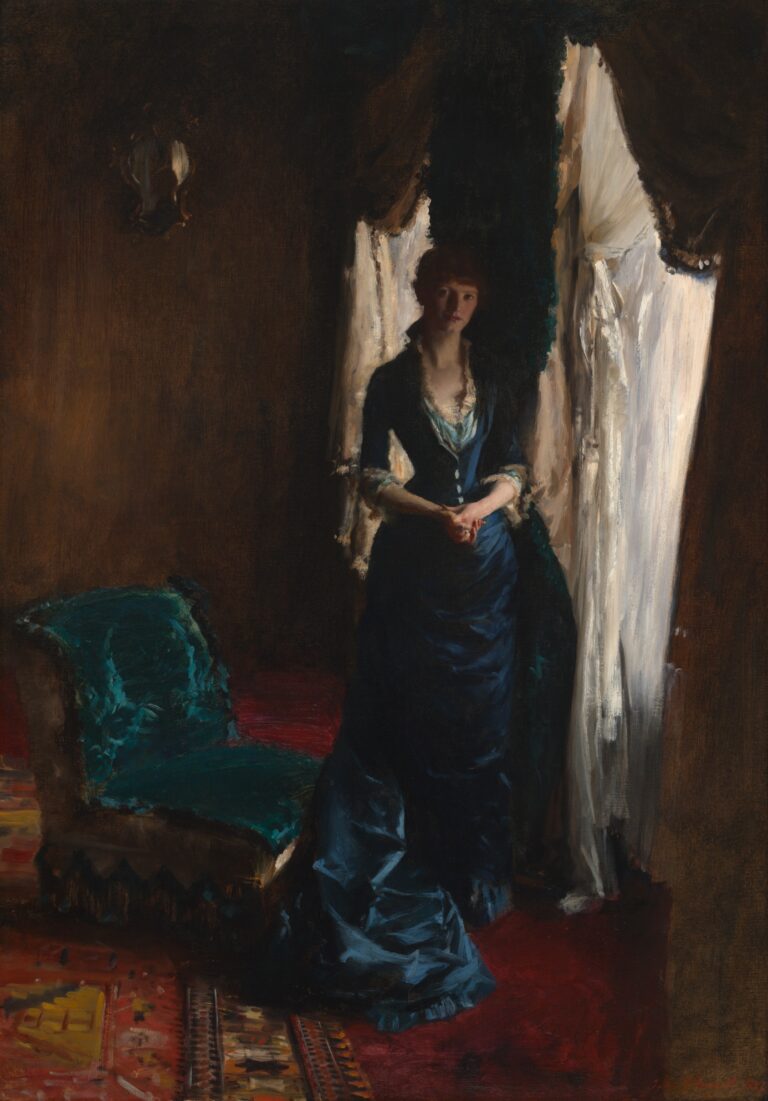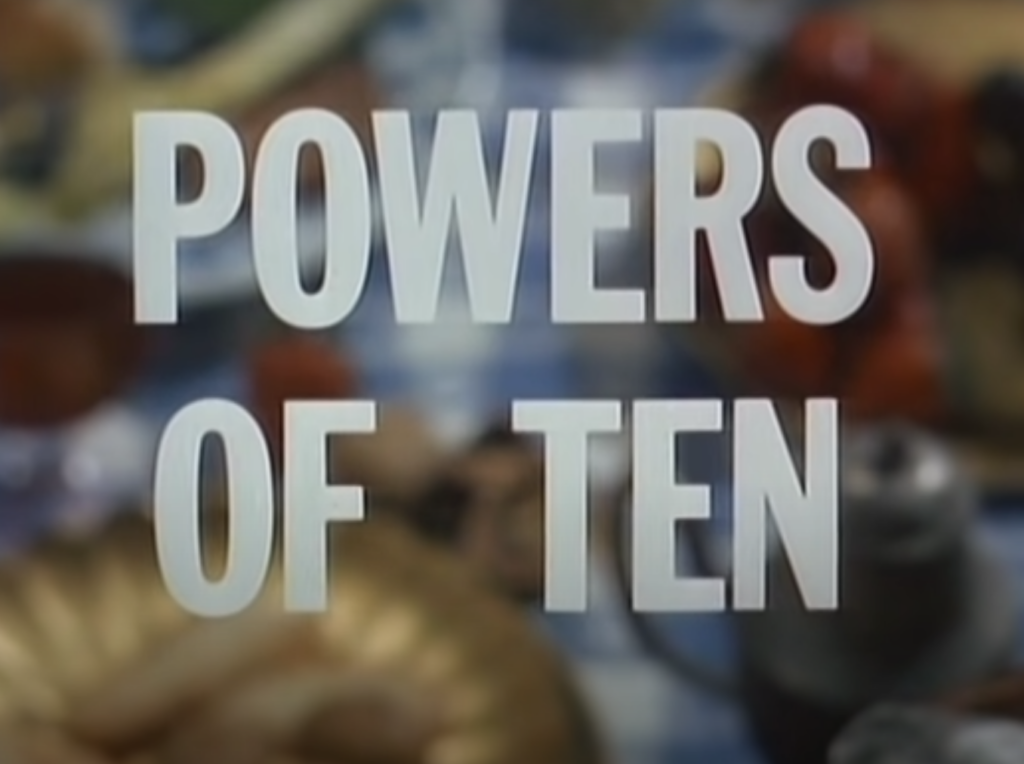blog atelier
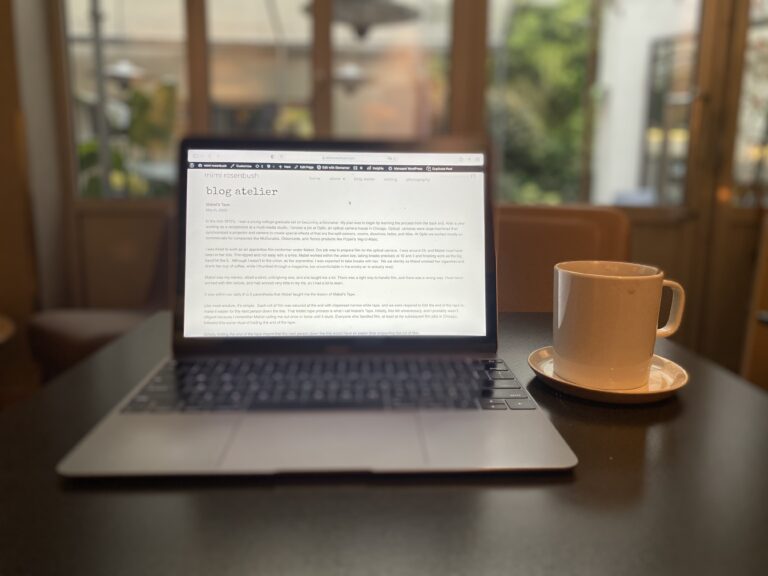
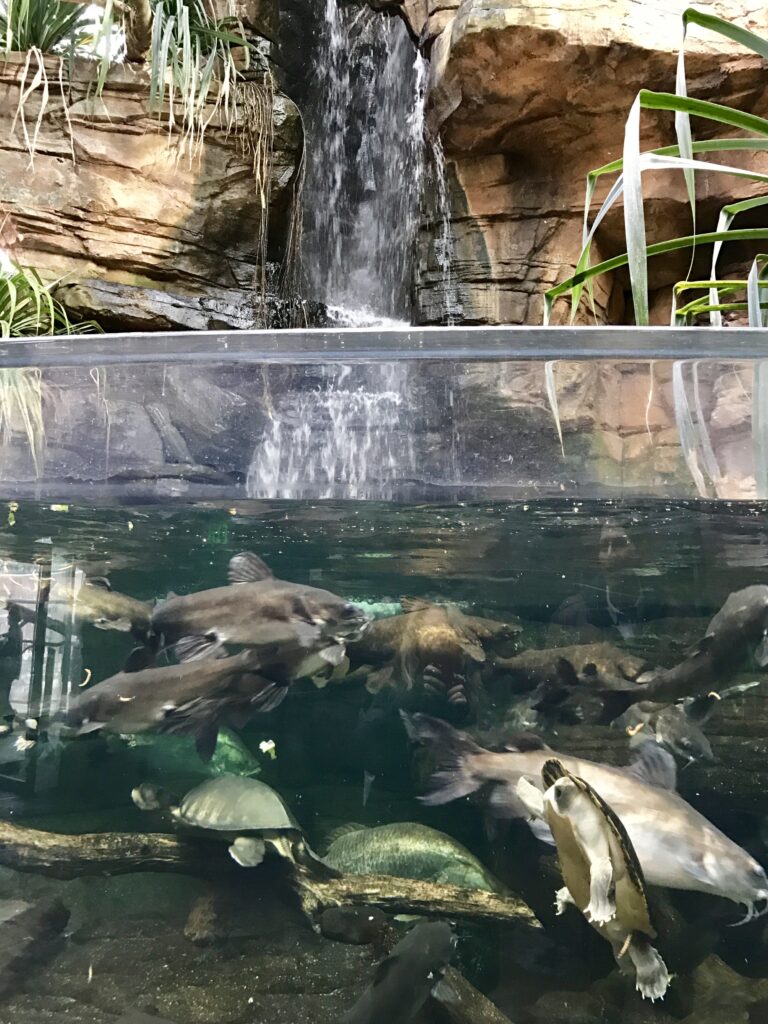
Reflection Photography and the Mirror Selfie
December, 2024
Reflection photography can be planned or serendipitous. I observe the reality around me as if I’m in the audience of a movie: more observer than participant.
In 2016, I took a serendipitous photo when my husband, Stu, and I were visiting the National Aquarium in Baltimore. A year after the photo was taken, I looked more carefully and saw Stu’s reflection on the right side, a touch below the water’s surface. I took the photo of the aquarium because Stu loved any body of water and when possible explored with his mask, snorkel, and sometimes scuba gear. We were visiting a medical center in search of ways to prolong Stu’s life – and as was our way – took advantage of the trip to explore.
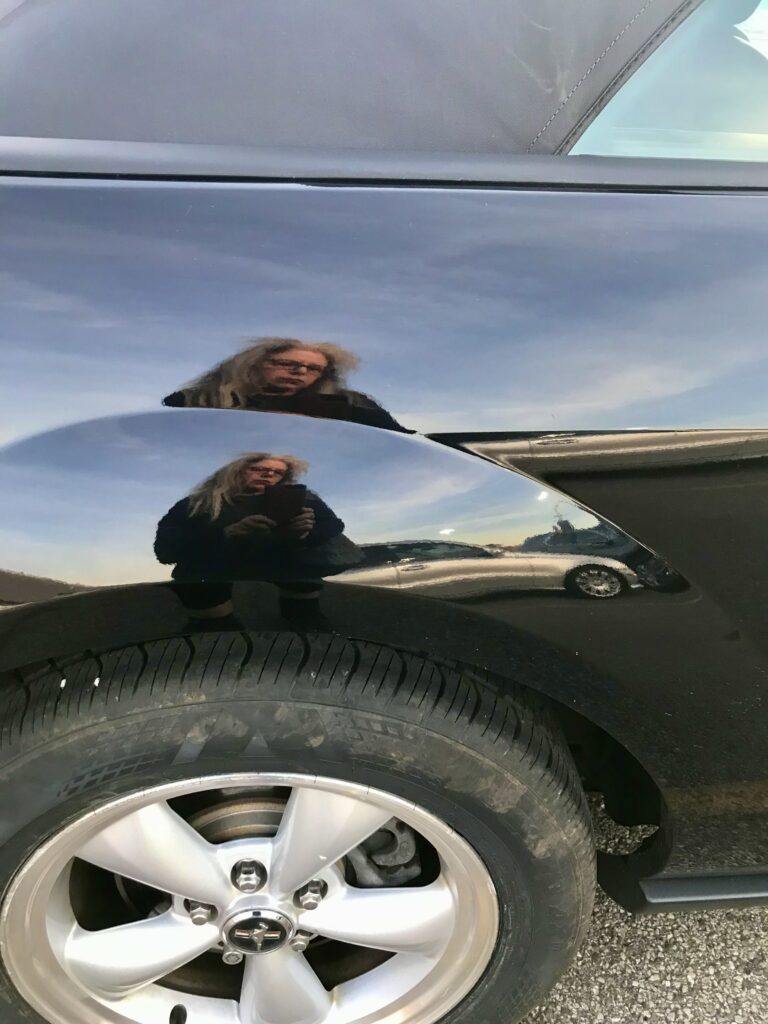
Most of the reflection photos I take are planned. Stu had been driving Mustang convertibles for most of our married life. Soon after he died, I made the decision to sell his beloved Black Mustang – by far his favorite car. I am known in my family, as an unsentimental person who doesn’t hold on to things. In spite of the obvious practical challenges of keeping a car I wouldn’t drive, this was a tough letting go. I wanted some documentation of the moment and knew that a reflected image would distance me in way a poem couldn’t – the distancing protected me.

What fascinates me about reflection photography are its layers of meaning and perplexity. This photo taken on the Chicago River in front of the Apple Store is a case in point. I think I’m standing with my back to the river and Lower Wacker Drive, but I don’t understand the orientation of the mirrored images. The reflection is disorienting, but at the same time grounded in my love of Chicago. I watched the Apple Store being built, thrilled by barges carrying its completed parts, like the roof – a giant iPad. The building of the Apple Store is not a part of the photo, but for me, it’s meaningfully present.

In Versailles’s Hall of Mirrors, I challenged the traditional foregrounded-selfie by diminishing myself and giving way to the opulent splendor of Versailles. In general, I tend to take mirror selfies when I’m traveling alone – as is the case in Kyoto, Japan photo on the right. Again, I see myself as an observer, and here I am observing myself observing the front entrance of this house. Layered meaning emerges when the doorway architecture behind me takes focus. This comes closest to how I feel when I relate to the world around me on the other side of a camera lens.
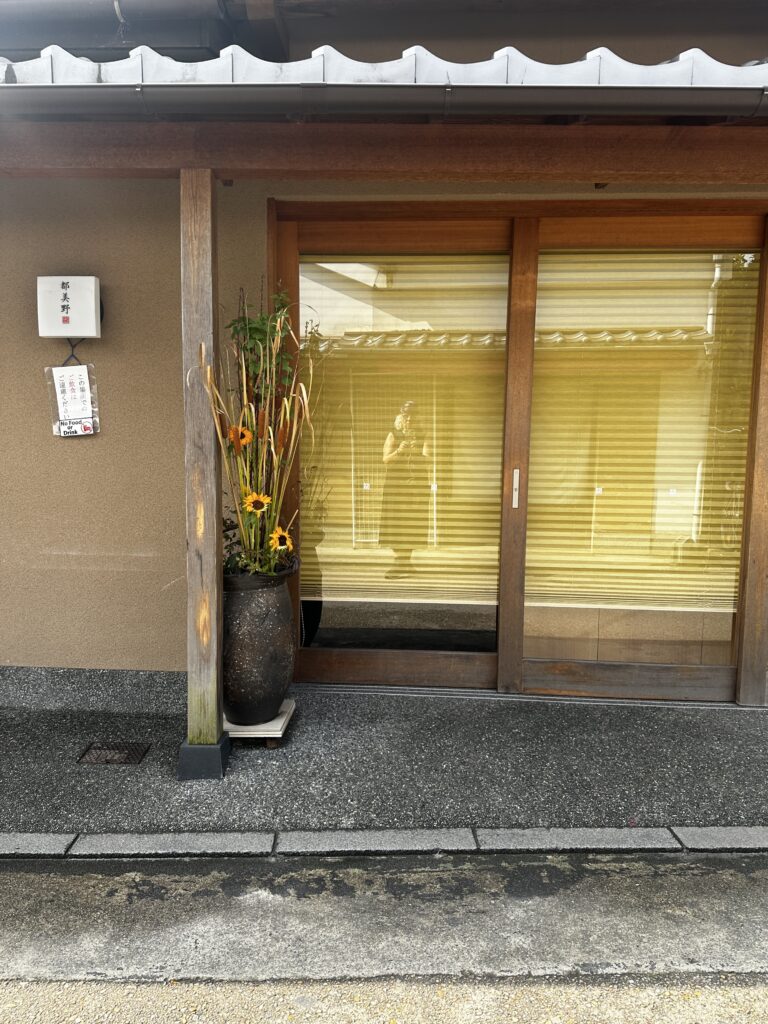
Although mirror selfies can be traced to the early 20th Century, Vivian Maier’s mirror selfies (and general street photography) particularly inspire me. She shot with a view-finder camera, similar to the one Stu’s dad brought to the US from Germany after the Second World War. Because the camera can rest below the photographer’s face, subjects can remain unaware that they are being photographed. This less threatening format allows the photographer to distance herself from the subject. (The photos I took in Nepal were taken with my iPhone, and I sometimes set up the photo, moving the iPhone below my face to make the subject more comfortable. As it turned out, the people in Kathmandu had no problem being photographed and sometimes looked approvingly at the image on my phone. See Photography.)

Stendhal and Me
August, 2024
Several times in my life, I have seen things so profoundly beautiful that they elicited a physiological response best described as an implosion from within. Until several years ago, I was unaware that I was experiencing my version of Stendhal Syndrome.
According to Wikipedia, “Stendhal syndrome, Stendhal’s syndrome or Florence syndrome is a psychosomatic condition involving rapid heartbeat, fainting, confusion, and even hallucinations, allegedly occurring when individuals become exposed to objects, artwork[s], or phenomena of great beauty. Stendhal syndrome was named after Marie-Henri Beyle (1783–1842), better known by his pen name, Stendhal.”
Upon visiting Florence, Stendhal famously wrote, “I was in a sort of ecstasy, from the idea of being in Florence, close to the great men whose tombs I had seen. Absorbed in the contemplation of sublime beauty . . . I reached the point where one encounters celestial sensations . . . Everything spoke so vividly to my soul. Ah, if I could only forget. I had palpitations of the heart, what in Berlin they call ‘nerves’. Life was drained from me. I walked with the fear of falling.”
Unlike Stendhal, I haven’t felt faint or confused, nor have I hallucinated. While I haven’t experienced anything as disturbing as Stendhal’s response to Florence, in the presence of “sublime beauty”, I do experience an ecstasy so overwhelming that it leaves me unsteady and somewhat dysfunctional.
I recently visited with my neighbor Gary and somehow our conversation turned to places we had found particularly moving. We shared stories of seeing our first glacier and visiting the Jungfrau in the Alps. But an experience Gary shared that surprised me – one I had forgotten – was the feeling I had inside the Pantheon in Rome. When Gary spoke of how moved he was in the Pantheon, I felt a visceral response – as if I was experiencing the Pantheon again.
Its mathematical perfection had left me overcome with something like Stendahl’s sense of ecstasy. It was good that I was by myself that day in 2021, so I could take in the space unencumbered by the need to move along with a companion. Initially, the experience caught me completely off-guard until I recalled the familiar feeling of familiar proximity with something awesome.
I continue to be unsatisfied with my explanation of Stendahl’s Syndrome and my reliable thesaurus offers words that only come close: overcome, shaken, awed, a sense of wonder, reverential. Reverential elicits a sense of Divinity, and that may come closest. Perhaps the Stendhal experience reveals something closer to G-d. Something beyond the limits of human language.

Being Between Things
April, 2024
When I first read Wordsworth’s My Heart Leaps Up, I thought of the space before birth and after death: a synapse in the midst of universal continuity. Like a wheel in space, the child and the parent slowly spin– one yielding the other – without beginning or end.
When someone dies, eulogies often reference the dash – a representation of life lived between the year of birth and the year of death.
As I’ve grown older, I’ve become aware of the vantage point that exists on the edges of the dash: the experience before someone is born and before someone dies, when there is a stillness, a waiting, an anticipation. We cannot imagine life without someone we love; we cannot imagine new life and who this person will be.
At both times, there’s a sense that something is about to be different from one point in time to the next. Being between things, for me, means accepting what is unknown and what is unknowable with a sense of promise and adventure.
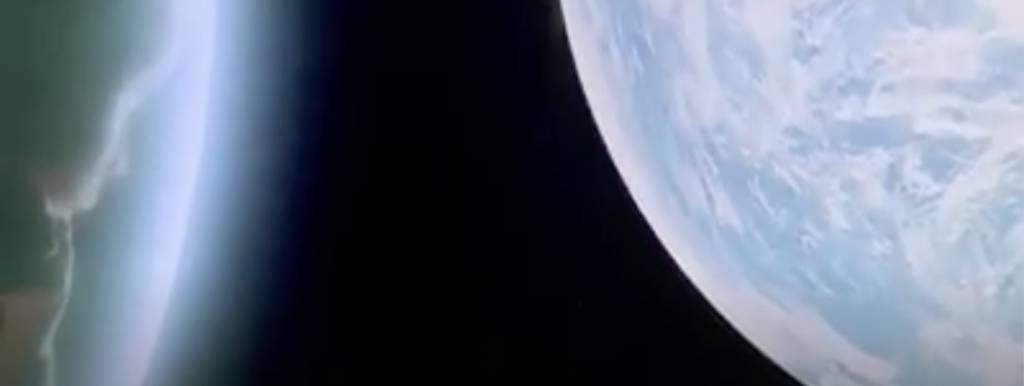
My Heart Leaps Up by William Wordsworth
My heart leaps up when I behold
A rainbow in the sky:
So was it when my life began;
So is it now I am a man;
So be it when I shall grow old,
Or let me die!
The Child is father of the Man;
And I could wish my days to be
Bound each to each by natural piety.
Travel in Time of War
November 2023
This place without conflict on the ground. No young soldiers fighting, no missiles, no hostages, no university insanity. No moral compass lost: North seems true. But I don’t live here, so that may be a fantasy.
Children play in dusty rocky lots kicking a ball here, flying a kite there. This is what it was to be alive on October 6th, to be alive the day before. I’m in a time machine of peace where place seems to change everything, but changes nothing at all.
I can ride the arrow of an airplane map and be in Israel, but I’m here, in the valley of the Himalayas. The same sun warms this side of the planet, but elsewhere mothers weep, families wait, and my homeland fights for peace.

Before the Yahrzeit
August, 2023
How does one live in and through a time when the person held most dear is fading away. I don’t know how; I only know that I was as present as was possible. One gets on with things, doing daily chores, making calls, keeping people informed. It was exhausting, but not as exhausting as grief would be.Contradictions flourish and coexist. It’s too much, but it’s not enough. Someone is dying, but still alive and present. We wonder how long the dying will take, but we don’t want the end to come. We want the person to hold on, but understand the selfishness behind that.
Late at night, my mind ran dress rehearsals of the future. I wondered what it would be like to be on my own for the first time, to be a widow: a noun without luster, riddled with negativity. In film and theater, often a forlorn, pitiable person. Someone deserving of love, but without the person who loved them most: perhaps half of a whole. It became a new identifier – a jarring box to check, but eventually, I would embrace it, with a life-affirming curiosity.
The loss of a daughter-in-law, like the loss of a close friend, does not activate an identifying noun. This loss offers no title, reflecting the nameless abyss that follows. When Tess (my daughter-in-law) died, I stood in a hallway pitch dark like a moonless sky, the walls wailing and screaming like a siren until I couldn’t stand anymore. I had to hold my ears from the screech of it, but this didn’t help. Nothing helped.
When my husband Stu died, the early September sun poured through my window. I stood on top of a hill with clouds puffy in the sky and a warm soft breeze around me. I rolled down the hill’s gentle green meadow slowly tumbling without pain or fear. In free fall, I heard nothing at all – not a bird, not the movement of a tree. Stu’s death left the world silent.
Before the yahrzeit and before the Jewish New Year, the lowest registers of sound emerge from silence. Everyone lost returns with a gift of connection. I feel this in my kitchen and at my desk. Ancestors I knew, those who came before, and Stu’s family who died just before we were born when Europe was on fire: they all return to me.
There is heartbreak in that moment, but when I quiet down and listen, there’s a steady comforting droning sound that rests under everything. It’s always there in its regal omnipotence; all I have to do is quiet down and listen.
The late Frank Miller, principal cellist with the Chicago Symphony Orchestra 1959-1985, playing opening of the Saint Saens Cello Concerto in 1962:
Musical Exposure (Part 2)
May, 2023
I play in a cello ensemble organized last year by my teacher. We are usually five players, ranging from cellists who have been playing for decades to a few newer players, like myself.
The cello is played on four strings – C, G, D, and A – A is in the highest register. The parts I have played in ensemble have been close to my level of playing – challenging, but possible. Sometimes the notes are on lower open strings, offering a rich accompaniment with little effort, and I often share my part with another player, which provides an ensemble safety net.
But this winter, I was given the lead part for the first time, and although musical themes pass to other players throughout the piece, it’s still Cello Part 1.
Here’s the image that came to mind the first time I played Cello Part 1: I am on one side of a mountain, and I have to cross to the next mountain on a tight rope over an expansively deep chasm. To remain steady, I keep my eyes forward and try not to think of the drop below.
To play the lead part, one dispenses with caution and inhibition, and instead, excavates for honesty and a bit of bravery. For me, a note on the cello’s highest string (A) in 5th position is a scary place because I’m raw and exposed, with no place to hide. If I play tentatively, the sound is compromised. If I play full-on, I risk a disturbing out-of-tune note.
I attempt to master this piece, on my level. I practice over and over. Sometimes my mind wanders to a to-do list, or I check the time. But there are other times when I enter a flow, where practicing becomes its own world in space and time.
In a state of flow, I surrender to the music. This is a peculiar place where agency intersects passivity: practice and technique balance with forces of gravity and physics, and I enter that stratospheric performance space without a safety net.
Music as Metaphor (Part 1)
April, 2023
I’ve been playing cello for 2 ½ years and am approaching the end of Suzuki Book 3. Although I’m a goal-oriented person, I’m easy on myself when it comes to progress in the Suzuki repertoire. I understand that some pieces are going to take weeks/months to get through because of new techniques to (sort of) master and more theory to (kind of) understand. What’s important is learning, not turning the page to another piece.
Taking apart a phrase of music, adding a note, playing a riff six times, adding another note, then another measure – this system transports the cello from producing sounds resembling dying barnyard animals to sounds resembling music. As an adult, the purpose behind meticulous practice is easier to understand, so easier to commit time to, and thus more likely to yield results.
Playing music, like learning a language or other chip-away-until-something-improves endeavors, provides its own practice space by breaking large tasks into small measurable pieces. Playing music creates understanding of the relationship between fractious small pieces and the larger whole.
Blue Reverie
December, 2022
Sometimes, when I visit my neighborhood Starbucks, a woman arrives in the afternoon, orders coffee, and finds any open seat. Without putting headphones on to cancel ambient sound, she pulls the tabloid-style Chicago Sun-Times from its sheer apricot-plastic sleeve and opens the newspaper. After checking her phone, she puts on glasses and begins to read the paper.
Getting comfortable, she peels off her deep blue sweatshirt and drapes it over the chair behind her. The December solstice light filters through the Starbucks window, touching the sweatshirt’s blue folds.
The woman reads attentively, unaware of my eyes on the back of her chair. I am captivated by the sweatshirt tableau and am transported to John Singer Sargent’s fabric folds in his Gilded Age portraits hanging in Chicago’s Art Institute.
After a short while, the woman pulls on the deep blue sweatshirt, checks her cell phone again, and a takes a library book from her bag, which engrosses her for the rest of her visit.
Billie Holiday sings All of Me on the Starbucks sound loop, providing a pre-Christmas hiatus from caroles and Burl Ives. While late 19th century classical music may seem more appropriate for my blue reverie, Frank Sinatra and Ella Fitzgerald soon follow – a perfectly orchestrated sound mix for the December afternoon – watering my eyes with thoughts of my dad.
Mabel’s Tape
March, 2022
In the mid-1970’s, I was a young college graduate set on becoming a filmmaker. My plan was to begin by learning the process from the back end. After a year working as a receptionist at a multi-media studio, I landed a job at Optix, an optical camera house in Chicago. Optical cameras were large machines that synchronized a projector and camera to create the special effects of that era like split screens, zooms, dissolves, fades, and titles. At Optix we worked mostly on commercials for companies like McDonalds, Oldsmobile, and Ronco products like Popeil’s Veg-O-Matic.
I was hired to work as an apprentice film conformer under Mabel. Our job was to prepare film for the optical camera. I was around 24, and Mabel must have been in her 50s. Thin-lipped and not easy with a smile, Mabel worked within the union box, taking breaks precisely at 10 and 3 and finishing work as the big hand hit the 5. Although I wasn’t in the union, as her apprentice, I was expected to take breaks with her. We sat silently as Mabel smoked her cigarettes and drank her cup of coffee, while I thumbed through a magazine, too uncomfortable in the smoky air to actually read.
Mabel was my mentor, and she taught me a lot. There was a right way to handle film, and there was a wrong way. I had never worked with film before, and had worked very little in my life, so I had a lot to learn.
It was within our daily 9 to 5 parenthesis that Mabel taught me the lesson of Mabel’s Tape.
Like most wisdom, it’s simple: each roll of film was secured at the end with a dispensed narrow white tape, and we were required to fold the end of the tape to make it easier for the next person down the line. That folded tape process (the tape-fold) is what I call “Mabel’s Tape”. Initially, the tape-fold seemed unnecessary, and I probably didn’t take it seriously because I remember Mabel calling me out once or twice until it stuck. (Everyone who handled film, at least at my subsequent film jobs in Chicago, followed this same ritual of the tape-fold.) And when I eventually worked on the Optical Camera and in film editing, Mabel’s Tape made my job easier and faster.
Folding the end of the tape means that the next person down the line will have an easier time unspooling a roll of film. When one applies this idea to daily life, the effects are enormous: imagine each person making things less difficult for the next person.
Rarely a day goes by that I don’t think about Mabel’s Tape and how much better the world would be if we all practiced its lesson. Mabel’s Tape reflects a certain civility that could, most certainly, lead to world peace. Just imagine Mabel arriving in Stockholm, Sweden carrying her pocket book (like the Queen) and matter-of-factly accepting the Nobel Peace Prize on behalf of Mabel’s Tape. Maybe she would even crack a smile.
The Yellow Spiral Notebook
February, 2022
Without the guiding structure of a job to keep me honest time-wise, Spring of 2020 presented not only a challenge, but an opportunity to get things done. In addition to “make the best of things,” the dominant mantra in the opening days of Covid lock-down was from Hillel in Ethics of the Fathers (Pirkei Avot): “if not now, when?”
Of course, nothing was going to happen on its own. What was required was a system of accountability, so in addition to daily calendars (online but mostly on paper), I began writing the Yellow Spiral Notebook.
Similar to a paper calendar, the Yellow Spiral Notebook offered more room for breath and expansion. In headline letters, each page heralded – Day of the Week! Month! Day! Year! Each page honored its day. Finish that day, and turn the page on its coiled spiral axis to a new college-ruled page of promise and possibility.
The pages were nothing revolutionary: think large planners used for school or work, but what made this notebook different, and even necessary, is that it approached the week as if I were still going to work or school. It transformed the theoretically vague to a state of heightened personal productivity.
Everything was written down in a checklist: sometimes bulleted and sometimes numbered. Each day sectioned out by the time of day – some days filled with schedules, some more airy and light – each page replicating the nature of the day itself.
The Yellow Spiral Notebook gave the impression, albeit a false one, that I was in control of a day. This deception resulted in a sense of power in my ability to get things done. And stuff did get done until, of course, one was temporarily derailed by a leaky pipe, a cry for help, or devastating news. The Notebook works until it doesn’t or until it can’t. It works until life gets in its way.
By March, 2021, a year after its debut, the representation of each Yellow Spiral Notebook day had become haphazard and random as I spiraled into exhaustive grief for my daughter-in-law Tess.
Sure, stuff got done, but so much did not, and the collapse of the Yellow Spiral Notebook culminated in a troublesome oxymoron: a disorganized Pesach (Passover). One simply cannot have a disorganized Passover. It just doesn’t work.
The year of forward motion and sense of purpose was displaced by disorientation. I was not so much derailed, but I was definitely stopped in my tracks. My family sat around the more-roomy Passover table with three people absent in just a handful of years: my husband, my dad, and my daughter-in-law.
As Covid re-entry tracked upward, entries in the Yellow Spiral Notebook tracked downward. Schedules were no longer meticulously hand-printed, lists disappeared, days were unaccounted for, and in the midst of chaotic but welcome displacement
I was vaccinated (euphoria);
I could hug my kids (joy);
I stepped into more public places (tentative).
I caught my breath in August, 2021, and the Yellow Spiral Notebook (there were several) retired from its days of glory and became a more casual version of its former self. This is partly because the habitual structures developed over that year and a half didn’t require announcing or recording. They had become a part of me.
By fall of 2021, the Yellow Spiral Notebook was back but diminished in its authority: it continues in this capacity into 2022. Keeping track still matters, but many of the habits cultivated in the spring of 2020 no longer required notebook accountability. (However, when I falter, the Notebook regains its authority.) Today, the Yellow Spiral Notebook remains malleable and less of an historical record.
One day, I may even throw them all away.
A World War II Story
November 11, 2021
I can’t separate my dad’s stories of the War in the Pacific from the 24-hour restaurant on Chicago’s Northside where they were told. I would slip into his usual neolithic vinyl booth, as “his” waitress kept the iced Diet Cokes coming. To the accompaniment of clanging sturdy plates and cups, dad transported me to his time as Staff Sargent Arthur Strilky, radio operator on the B-29 bomber, Hog Wild.
My focus sharpened each time he talked about August 29, 1945, when a mere two weeks after V-J Day, Hog Wild was shot down over northern Korea by the Russians. That’s the day, at this strange intersection of the close of World War II and the start of the Cold War, that my dad got a second chance.
On August 29, 1945, Hog Wild flew out from its home base on the island of Saipan, two weeks after flying its last combat mission over Osaka, Japan. With its crewmen and two observers on board, it was tasked with finding the former Japanese Konan POW camp and to air-drop humanitarian supplies.
But as Hog Wild approached Konan (today’s Hungnam, North Korea), four Russian Yak Fighters suddenly moved in alongside, signaling the plane to land. Commander Joe Queen had direct orders from General MacArthur not to land the B-29 Superfortress on any Russian landing field, so he resisted.
The Yaks persisted and fired at Hog Wild, hitting its number one engine and left-landing gear. With engine ablaze, Pilot and Second Lieutenant Robert Rainey passed on Commander Queen’s bail-out order to the crew and two observers.
Six men parachuted over the Sea of Japan, eventually saved first by their May West life vests and several hours later by Korean fishermen.
Dad was about to jump, when Rainey quickly passed on Joe Queen’s split-second directive to stay on board and prepare to crash-land. They were too close to the ground to parachute out. Within seconds, dad was bracing for the crash, shaking in terror, and crying for his mother.
At 19, he was the crew’s youngest member, having enlisted after graduating from Chicago’s Senn High School.
Queen and Rainey brilliantly crash-landed Hog Wild on the Russian controlled airfield. Dad, and anyone still on board, jumped through the front of the plane (imagine the front window of the Millennium Falcon, inspired by the B-29) with engine ablaze. Ground crew Russians threw dirt on the engine, eventually putting out the fire.
After debriefing, dad went to the Konan POW camp, where he joined war-torn, emaciated British and Aussie POW’s, who had been captured in Singapore. My dad choked up every time he told the story of those men, who never failed each morning to stand at attention and salute the raised Union Jack. One of them carved a plaque for dad, which we still have.
Several nights later, dad and members of the crew pulled Hog Wild’s radio out of the wreckage and rigged it for transmission. The crew of Hog Wild were MIA, and it was imperative– as radio operator – that dad communicate their location.
Ill with dysentery, he weakly set out late at night to message Guam. The Russian guards were nearby, oblivious in their vodka-induced sleep. Each night, dad would tap out Hog Wild’s call numbers … And each night, no one replied.
Dad could feel their excitement through the Morse Code tapping style, when, after several nights, a tentative transmission came through from Guam:
Dad: 7 – 0 – 1 – 3 – 6.
Guam: 7… 0 … 1 … 3 … 6?????
Dad: 70136!
Guam: 70136!!!!!!!!
Even sixty years later, when he told that story, I shivered imagining that moment, oblivious to the corned beef sandwich orders proliferating in the Northside Chicago restaurant.
Hog Wild’s entire crew survived and were rescued in September, 1945.
Dad, who passed away at 93 in April, 2019, was a gifted raconteur and would captivate any willing listener, but narratives of bombing missions in the last months of the War in the Pacific were never told with the bravado of other tales. There was no embellishment, no poetic license.
Rather, war stories were told with simplicity and clarity, like he was running through his old carousel slide projector, one image at a time:
Hog Wild taking off from the Saipan cliff with a belly full of fuel and bombs – barely making it into the air.
Showing a crew-member, who had never seen a Jewish person before, that Jews don’t have horns.
Seeing unending rows of graves at Iwo Jima and feeling overwhelming gratitude.
But words evaded him when he attempted to describe two seminal moments: flying over an obliterated Hiroshima days after the bomb was dropped and Hog Wild’s own participation in the fire-bombing of Tokyo.
My brother, Rick, explains that our dad was caught between a patriotic aesthetic and the moral aspects of war. His pride was subdued by the weight of moral imperative. Flying toward Tokyo, in the spring of 1945, dad peered out of Hog Wild, taking pride in American strength in the skies and the majestic beauty of the scene.
But morally, he could not reconcile bombing hundreds of thousands of civilians.
Dad was overwhelmingly grateful to have survived, and to have been given what he always called, his second chance. After the war, he got on with things. But his personal remorse never dissipated.
I remember in 1968, during the Tet Offensive of the Viet Nam War, seeing him sitting in a chair near the window of our apartment on Stratford Place, in Chicago, reading the newspaper. He put the paper down and looked at me – his eyes filled with tears. He was crushed by the news. The Viet Nam War, he said, was senseless and unnecessary. Too much innocent life lost.
It brought him back to the bombing raids of Hog Wild. He knew that he was fighting a different war, but it was still difficult for him.
As Rick puts it, our dad was too sensitive not to face the reality of bombing Japan. He understood it intellectually, but he couldn’t avoid the loss of so many lives over and over again. This continued throughout the American 21st century. Time and again, he would recount the stupidity of human conflict.
Throughout his life, dad remained a gentle soul who avoided confrontation.
It’s been over two years since dad (known in our family as Papa Buddy) passed away, and when I think about sitting across from him in the booth of the now closed 24-hour Chicago diner and hearing his war stories, I think about the power of those stories and how anyone fortunate enough to listen was transported – unforgettably – to the Pacific Theater of 1945.
As he often said, you and your brother Rick wouldn’t be here if it weren’t for Joe Queen. When dad died at the age of 93, the crew of Hog Wild lost its last member. The reunions and holiday cards had stopped decades before, but now the stories, and answers to questions, stopped too.
______________________________________________________________________
The story of Hog Wild remains a puzzlement. There has been speculation about exactly why the B-29 Superfortress was shot down. Why was the crew divided and told not to speak of the incident? Why were there two observers on the plane? Conspiracy theories proliferate. Was Hog Wild on a spy mission? Did the Russians “just” want B-29 technology?
If you google “Hog Wild World War 2″, you’ll find articles, a book, and much historical speculation. Clearly, this nexus between the Second World War and Cold War has been ripe for theory.
The question is – where does this leave me. I decided to let the theories flap in the wind of the internet. They are not my concern. For some, they are definitely more than a curiosity, for me not so much. I can only relate to my dad’s story as a listener to that narrative.
After speaking with my friend Todd, a wise reader of stories, I thought of my distorted view of my dad’s years in the War and the Russian shooting down of Hog Wild.
I had thought that dad spent months in the POW camp, not weeks. The story grew in my mind in proportion to its significance to my dad. It’s not that I had a false understanding, it’s just that stories can expand in our imagination in relation to their significance to the narrator.
Perhaps that expansion takes us as close as we, the listeners, can possibly get to the real experience itself.
A salute today to all our veterans. And a special salute to you, dad, my favorite veteran.
November 11, 2021
John Cage and Writing Silence
August, 2021
During the spring and summer months, my blog and published writing took a rest. The January, 2021 euphoria of getting vaccinated was reduced to disorientation and silence. And as the world creaked open, the loss of my daughter-in-law Tess took occupancy and filled the space, leaving writing a journaling gush of emotion and grief. Of course, journaling is writing, but, for me, it wasn’t writing to be shared.
What happens when published writing takes a rest and is silent?
In music theory, a rest has musical value. It is an intrinsic part of the composition as a whole. According to Wikipedia: https://en.wikipedia.org/wiki/Rest_(music):
“A rest is a musical notation sign that indicates the absence of a sound.”
“Rests are intervals of silence in pieces of music, marked by symbols indicating the length of the pause. Each rest symbol and name corresponds with a particular note value, indicating how long the silence should last, generally as a multiplier of a measure or whole note.”
Sixty-nine years ago today, experimental composer John Cage premiered his “Silent Piece” – 4’33” (read four minutes, thirty-three seconds) in Woodstock, NY.
In this piece, Cage asks performers, of any instrument, to simply refrain from making music. In the following performance, the pianist assumes the posture and aspect of someone about to play the piano. The audience responds in kind, although the pianist’s fingers never touch the keyboard:
The performative aspect heightens a consciousness of the absence of musical sound. One is aware of other sounds around the performance – the occasional laugh or cough, and the business surrounding the pianist.
Not unlike an outdoor performance, I’m not so much attentive to the silence, as to the ambient sound.
I found this explanation of 4’33” helpful in shaping my relationship with the piece and with the idea of silence in music – and in writing:
The layers of artistic experience are evident here as “we are eavesdropping on someone else’s experience.”
Even in more conventional music, the absence of sound is part of the expression of a musical composition. Silence does not detract from the whole of a piece; rather, it makes room for sound and gives music a chance to fill space. It has value.
In the same way, a rest from published writing can be seen as part of the composition experience as a whole. It can offer a reset and re-orientation, and perhaps it can, like sleep, offer necessary healing from overwhelming grief.
While silence appears to demonstrate an absence of creative expression, or as Cage puts it, “an absence of intention”, this absence may simply be a necessary hiatus when both reader and writer take a breath to listen more carefully to the words that came before and for the words that will soon follow.
Oftentimes, we lament the absence of creative force. But silence is as real as sound: it is simply the expression of a different creative force.
March 15, 2021
The absence of live cultural experiences in 2020 is beginning to dissolve into a slow return to what we knew and haven’t known. We are almost a crowd again – at a museum, a concert, the theater, or the movies. Inspired by a year of covid-distancing, this begins a series that will examine the resonant live cultural experience.
In Praise of the Solo Art Exhibit
Alberto Giacometti Exhibit
Art Institute of Chicago, 1965
My experience of Giacometti was at a time of self-discovery and introspection within the context of the strong social pull of early teenage years.
After a triumphant exposition at the MoMA in New York, the Alberto Giacometti exhibit arrived in Chicago on November 5, 1965 and remained here for several weeks until December 12, 1965. I was 13 when I went with my parents.
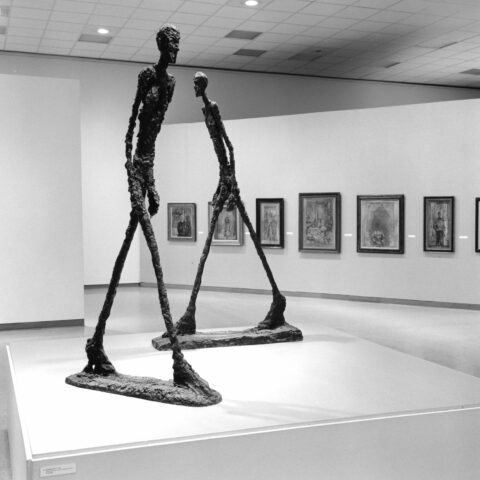
https://www.artic.edu/exhibitions/4656/alberto-giacometti
The Art Institute of Chicago, which co-hosted the exhibition, had added The Morton Wing in 1962 to display its expanding modern art collection and solo shows. Although I may have visited the Morton Wing beforehand, the thrill of walking into the Giacometti stays with me after over 50 years.
The Giacometti struck my 13-year-old self at a time of self-awareness. Like Giacometti’s attenuated figures, I was conscious of standing apart from myself to look within myself. Giacometti’s Femme or Walking Man had existential teeth. Although the elongated bronze figures were stylistically similar, they paradoxically represented the collective force of individuality and isolation.
For me, individuality was not so much isolating as it was promising. And as with so much of my experience of the world, the lens was more Wordsworth than Camus. I saw something in the nothingness.
This is the power of a singular museum exhibit: complete immersion and indelible impression. An argument can be made, as well, for an introduction to artists in the context of their time, their influences, and through museum scholarship.
The Giacometti exhibition in 1965 was my first memorable immersive art museum experience. It stands out as the first. But in conjuring up solo art exhibits, several come to mind:
Anselm Kiefer, Art Institute of Chicago, 1988
Gustave Caillebotte, Grand Palais, Paris 1994
Abstract Expressionist Artists in New York City, MoMA, October, 2010 (exhibition of a movement, not an individual artist)
Kerry James Marshall: Mastry at Chicago’s Museum of Contemporary Art, 2016
John Singer Sargent and Chicago’s Gilded Age, Art Institute of Chicago, 2018
Monet Water Lilies, Musée de l’Orangerie, February, 2020
My New Dog is a Cello
December, 2020
I haven’t been alone in my house as much as one would think. In the three years since my husband Stu died, friends have visited, and family has stayed for weeks and months at a time. Of course, there were the all-too-quiet evenings that morphed into the way-too-quiet nights, but not with the intensity of late fall, 2020.
In pre-Covid times, the experience of having people inside the house would resonate long after guests had left for the evening. Like the last measure of a symphony when the conductor’s baton poises motionless until the final note disappears, the quiet, on those evenings, continued to resound with suspended conversation deep into the night.
But then, it was more than quiet; it became lonely. The loneliness crept into my study, like Carl Sandburg’s fog – “on little cat feet.”
I don’t mind the solitude; I am occupied by studies on and off Zoom, and evenings are full and fulfilling. So I was surprised by this peculiar and unwelcome guest.
One thing was certain: this loneliness was a problem in need of a solution.
So, I decided to totally and unoriginally go 2020 and buy a dog. After the initial, What kind? What size? Shelter or Breeder? Fence for my yard? and so on, I entered the fun phase of imagining my canine pal.
This is how I approach change and possibility: I activate the idea, so that it becomes an imagined reality. This comes in handy for changes as subtle as repositioning a plant in the house, to grander notions of travelling, planning a Shabbat meal, or adding a sentient being to my home, like a dog.
On unpleasant days assaulted by sideways rain, I imagined outfitting-up and walking the dog. I imagined where they (gender not specific) would sleep, where the food bowl would live, and how to integrate the crate into my peaceful, uncluttered living space. How would the fence be placed without interfering with the show-stopping yew that my neighbor Rob and I love? I imagined the drive home with a puppy and delighting friends and family with the announcement of my warm, furry roommate. And, of course, I generated a charming list of names.
There are many advantages to living with a well-orchestrated imaginary experience. The most useful is that a definitive conclusion is revealed: either, this has been lovely (an imaginary vacation, for example) and now I can’t wait to really go, or this has been more troublesome than I had expected (an imaginary dog, for example), and I miss my freedom.
My yet-to-be-trained imaginary dog dragged me through a spiral of paradoxical reasoning: the dog would be a welcome companion, but I would need a human companion to help me with the dog companion. And so on.
My exercise in imagination led to the conclusion that this was not the time for a dog.
So how did I segue from dog to cello?
As one does these days, I tapped into an experience that had brought me joy. As a teenager in Chicago, I played violin in high school orchestra along side my lifelong friend Hiroko. However, I wanted to leave the squeaky mediocrity of my violin playing (most definitely not a joyful memory) behind me, and what better string instrument to embark upon than the resonant cello. I had had some additional exposure to string instruments from my kids’ junior high days; I can read bass clef; and I would get to play the instrument sitting down (which may come in handy as I approach my 70’s).
My new dog is a cello. And I’m thrilled.
The imaginary cello exercise never reached the colorful pitch of the imaginary dog exercise. I simply rented a cello and found a teacher (who teaches on FaceTime). I do hope that in a few years, I may join an amateur orchestra or string ensemble (again tapping into the joy I shared with Hiroko), but it would be presumptuous and down-right delusional to even imagine playing the gorgeous Bach Cello Suites or ascending the heights of the Dvorak. One must exercise some of responsibility over imagination.
Being a beginner will do just fine for now.
These past weeks, in the shortened daylight hours of November and early December, 2020, I sit down, facing the music stand at my study window. The light is changing beautifully and perceptibly, as I position the cello and rosin my bow. I’m on page one, book one. As basic as it gets.
As afternoon softly shifts to evening, I see loneliness move on through my window, past the rooftops, to the city and harbor beyond.
The fog comes
on little cat feet.
It sits looking over
city and harbor
on silent haunches
and then moves on.
Carl Sandburg
The Blog as Blague
November, 2020
I find it interesting? ironic? representative of a truth? that the French word for “joke” is blague – easily confused, in its oral articulation, with the late 20th century neologism, blog.
The term blog was coined in the late 1990’s, as a blend of the words Web (as in World Wide Web) and log. According to Etymonline.com, blog is a noun meaning “online journal” short for weblog (used here in the 1993 sense of a “file containing a detailed record of each request received by a web server”).
It would be interesting to look into scholarship on blogs, diaries, and the genre of autobiography in general, but for now I remain focused on my troubled relationship with the idea of writing a personal blog.
When I tease that the blog is a blague, I’m deflecting attention from my own ambivalence about personal blogging. I understand the popularity and usefulness of a food blog, for example, or of a health & fitness, diet & nutrition, DIY project, home décor, or lifestyle blog – all among 2020’s most popular blog topics. Not to mention my daily delight in reading Rex Parker Does the NYTImes Crossword Puzzle. However, I doubt the usefulness of a personal blog.
(I suppose “usefulness” is probably off the mark when considering the personal blog, altogether.) Nevertheless, I over-think the idea of a personal blog, taking it far more seriously than it merits.
With the Blog Atelier, I created a workshop space for work completed and in progress.
But in all honesty, calling this a Blog Atelier was an evasive measure to bypass my doubts about the value of personal blogging. Adding another name and in another language was a way of tap dancing until the real act was ready to come on stage: A meta-personal blog post – voila.
